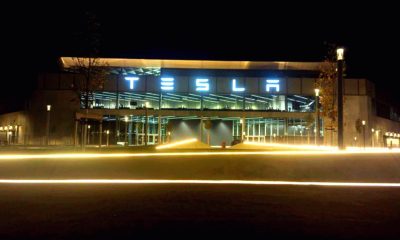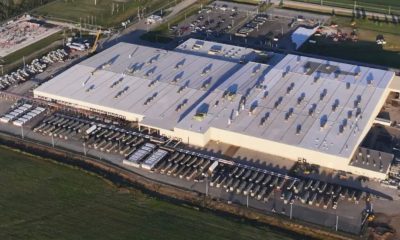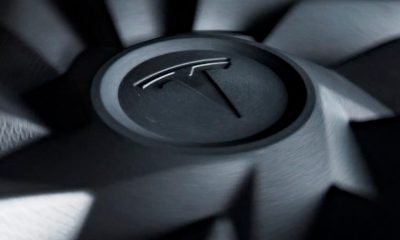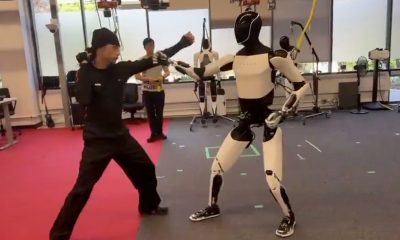Lifestyle
Hyperloop Competition Receives a Big Lift from SpaceX
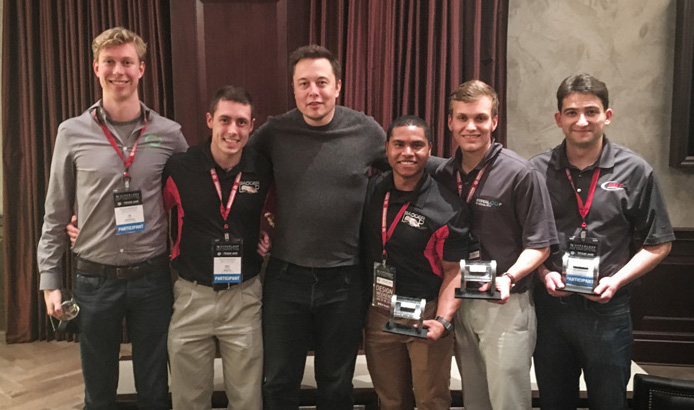
If you did a timeline of all the major Elon Musk announcements in the last five years, it would have a lot circles on the X axis. One circle would include the Hyperloop white paper.
Musk “dropped” off the concept to the world back in 2013 and moved on. However, last year Musk and SpaceX introduced a Hyperloop pod competition for college students to take place at SpaceX’s test track in August 2016.
Most Elon Musk devotees probably know a bit about the Hyperloop white paper released in 2013 and how this “fifth mode” of transport offers a low-cost solution versus high-speed rail proposals floating around the U.S.
The Hyperloop concept from Musk involves a low-pressurized air tube structure — say from San Francisco to LA — and propels passengers in a “pod” compartment at speeds of more than 700+ mph. The pod shoots through this low-pressure tube with induction motors intermittently placed in the track that moves the compartment. These motors “would provide a reboost roughly every 70 miles,” according to the paper.
After seeing SpaceX land a rocket on a tiny barge in the ocean, this doesn’t seem so far-fetched. Companies like Hyperloop Technologies and Hyperloop Transportation Technologies are currently working on proof-of-concepts and test tracks.
In January 2016, SpaceX held the Hyperloop Pod design competition at Texas A&M and evaluated more than 124 concepts, which included best overall concept and innovation. Thirty plus university teams were picked to move on to competition weekend at SpaceX’s Hawthorne facility, where a mile long test track — six foot in diameter steel tube — is being built.
The MIT Hyperloop team won the best Overall Design Award while the Pod Innovation Award went to the Delft Univ. of Technology in the Netherlands. The event also awarded BadgerLoop, from the Univ. of Wisconsin, with the 3rd place and the Pod Technical Excellence award.
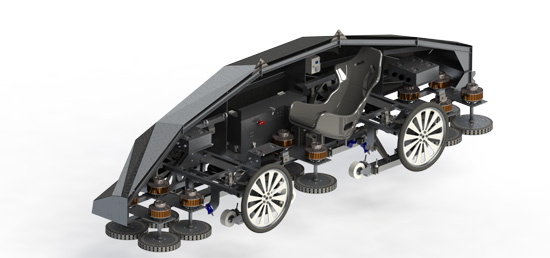
BadgerLoop’s pod will reach speeds of up to 200+ mph in a matter of 15 seconds with a run lasting approximately 43 seconds.
Being based in Chicago, I reached out to the BadgerLoop team in March and interviewed multiple members of the team, including a Co-President, the Electrical and Controls Manager and, of course with Hyperloop, the team’s Levitation Lead.
Teslarati: So how many students are on the BadgerLoop team?
David Van Veen, Operations Director: We have a 150 dedicated members helping in all aspects related to the competition and have about 75 student engineers working on the pod project.
Brett Sjostrom, Co-President: We have something special with this team, we’ve been engineering students for three or four years and BadgerLoop is going up against teams with much more experience. The MIT Hyperloop team is made up of graduate students and some of those folks interned at NASA, SpaceX and Boeing.
The aluminum sub track in Hawthorne will be flat and this allows the BadgerLoop team to move past the air bearings concept from Musk’s white paper. BadgerLoop is implementing a Halbach Arrays concept.
Sjostrom: Halbach arrays are a certain configuration of magnets that amplify the magnetic field on one side, and negate it on the other side of the array. Passing this array over the aluminum sub track creates eddy currents which give our pod its levitation.
Teslarati: How does your Hypeloop pod differ from other teams?
Van Veen: Other teams are using passive Halbach arrays which provide just vertical levitation but there’s no forward propulsion to it.
Bill Carpenter, Levitation Lead: Our design creates drag from the levitation but by spinning the wheels — using drag — in the opposite direction, we can create thrust to move the pod forward. Our pod has a total of ten Halbach Array wheels, four in the front and back, and two in the middle.
So, it’s negating our drag and providing a truly frictionless ride. It’s also providing that contactless stability in all directions. Plus, it’s an active system so we can control it, speed it up or slow it down.
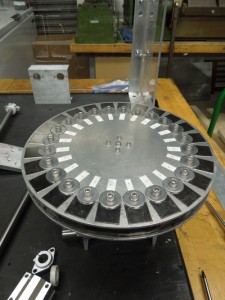
Here’s an example of BadgerLoop’s Halbach arrays on a wheel. The configuration of magnets amplifies the magnetic field on one side, and negate it on the other side of the array. Passing this array over the aluminum sub track creates eddy currents, which produces the pod’s levitation.
Obviously, stability is important with a $150 million test track located next to the company’s headquarters. Most of SpaceX competition specifications for a test run involve many safety hurdles to actually get on the track in August.
According to Badgerloop, these pods will reach speeds of up to 200+ mph in a matter of 15 seconds with a run lasting approximately 43 seconds. That’s why BadgerLoop’s pod will have more than 140 sensors on board for real-time safety data and avoid overheating motors and other components.
Teslarati: Can you provide an overview of your pod controls and sensors?
Eric Amikam, Electrical Team Lead: Our pod will have 114 sensors. These include proximity sensors for between the pod and the rail, acceleration and gyroscopic data. We’re also taking in almost 50 different temperature points that create a full, live thermal heat map of our pod.
Teslarati: Why so much thermal sensing?
Eric Amikam: We’re in a vacuum and don’t have the benefit of convective heating like you normally do, so we have to make sure that everything is very thermally regulated. We have a variety of thermistors placed all throughout the pod and it goes to one central location. We can look at our dashboards in the middle of a run.
If one of our motors is getting dangerously hot and we don’t want to break that motor, we can just shut it off remotely.
Eric Amikam: In a couple months here, we will have a full simulation from dynamic model via CANalyzer from Vector — Tesla Motors uses the using the same software. The simulation allows us to infer “over the course of these 42 seconds, here’s what all of the sensors should see.” Then, we’ll fake all that data in our CAN bus, at the hardware level, and see how the system reacts. From there, and we can fine tune it, debug, test out our fault codes and start up sequences.
Sort of a Big Deal (Not Ron Burgundy)
Of course, meeting the International Man of Action, Elon Musk, was a bonus for Co-President Sjostrom and Tieler Callazo during the Design competition at Texas A&M.
“The lead SpaceX Hyperloop engineer appears on stage and says there’s been a recent hashtag on Twitter about where’s Elon. And we’d like to answer that question,” says Sjostrom.
Then, Elon Musk walks out.
The top four teams’ presidents were able to meet with Elon Musk one-on-one and discuss their pod designs. “We were waiting for Musk to finish his conversation and all the other team presidents were just repeating, ‘We get to meet Elon Musk, this is awesome.’”
Sjostrom adds “Musk thought it was pretty impressive that the top four teams were doing magnetic levitation and the first Hyperloop would probably be a wheeled vehicle, just like a proof of concept.
BadgerLoop is building the aluminum pod as the semester winds down and hopes to start integrating the different sub-systems and apply the carbon fiber skin in May. The team is utilizing workplace Slack software to help organize and oversee 40 members on the electrical team, for example. BadgerLoop will have to rely on remote collaboration as some team members graduate in May.
“Regular students go to bed and we keep working,” says Van Veen. “The only issue is when do we sleep. That’s probably our biggest challenge to be honest.”
Looks like Musk is preparing the students for careers at Tesla Motors, SpaceX or Hyperloop.
* All the Hyperloop college teams are looking for funding as this is a capital intensive project. You can donate to BadgerLoop by visiting this page.
Lifestyle
Tesla Model S Plaid battles China’s 1500 hp monster Nurburgring monster, with surprising results
There is just something about Tesla’s tuning and refinement that makes raw specs seem not as game-changing.

The Tesla Model S Plaid has been around for some time. Today, it is no longer the world’s quickest four-door electric sedan, nor is it the most powerful. As per a recent video from motoring YouTube channel Carwow, however, it seems like the Model S Plaid is still more than a match for some of its newer and more powerful rivals.
The monster from China
The Xiaomi SU7 Ultra is nothing short of a monster. Just like the Model S Plaid, it features three motors. It also has 1,548 hp and 1,770 Nm of torque. It’s All Wheel Drive and weighs a hefty 2,360 kg. The vehicle, which costs just about the equivalent of £55,000, has been recorded setting an insane 7:04.957 at the Nurburgring, surpassing the previous record held by the Porsche Taycan Turbo GT.
For all intents and purposes, the Model S Plaid looked outgunned in Carwow’s test. The Model S Plaid is no slouch with its three motors that produce 1,020 hp and 1,420 Nm of torque. It’s also a bit lighter at 2,190 kg despite its larger size. However, as the Carwow host pointed out, the Model S Plaid holds a 7:25.231 record in the Nurburgring. Compared to the Xiaomi SU7 Ultra’s record, the Model S Plaid’s lap time is notably slower.
Real-world tests
As could be seen in Carwow’s drag races, however, Tesla’s tech wizardry with the Model S Plaid is still hard to beat. The two vehicles competed in nine races, and the older Model S Plaid actually beat its newer, more powerful counterpart from China several times. At one point in the race, the Xiaomi SU7 Ultra hit its power limit due to its battery’s temperature, but the Model S Plaid was still going strong.
The Model S Plaid was first teased five years ago, in September 2020 during Tesla’s Battery Day. Since then, cars like the Lucid Air Sapphire and the Xiaomi SU7 Ultra have been released, surpassing its specs. But just like the Model Y ended up being the better all-rounder compared to the BYD Sealion 7 and the MG IM6, there is just something about Tesla’s tuning and refinement that makes raw specs seem not as game-changing.
Check out Carwow’s Model S Plaid vs Xiaomi SU7 drag race video below.
Lifestyle
500-mile test proves why Tesla Model Y still humiliates rivals in Europe
On paper, the BYD Sealion 7 and MG IM6 promised standout capabilities against the Model Y.

BYD is seeing a lot of momentum in Europe, so much so that mainstream media has taken every opportunity to argue that the Chinese automaker has beaten Tesla in the region. But while BYD sales this year in Europe are rising and Tesla’s registrations remain challenged, the raw capabilities of vehicles like the Model Y are difficult to deny.
This was highlighted in a 500-mile challenge by What Car? magazine, which showed that the new Tesla Model Y is more efficient, cheaper to run, and more reliable than rivals like the BYD Sealion 7, and even the nearly 400 KW-charging MG IM6.
Range and charging promises
On paper, the BYD Sealion 7 and MG IM6 promised standout capabilities against the Model Y. The Sealion 7 had more estimated range and the IM6 promised significantly faster charging. When faced with real-world conditions, however, it was still the Model Y that proved superior.
During the 500-mile test, the BYD nearly failed to reach a charging stop, arriving with less range than its display projected, as noted in a CarUp report. MG fared better, but its charging speeds never reached its promised nearly-400 kW charging speed. Tesla’s Model Y, by comparison, managed energy calculations precisely and arrived at each stop without issue.
Tesla leads in areas that matter
Charging times from 25% to 80% showed that the MG was the fastest at 17 minutes, while Tesla and BYD were close at 28 and 29 minutes, respectively. Overall efficiency and cost told a different story, however. The Model Y consumed 19.4 kWh per 100 km, compared to 22.2 for MG and 23.9 for BYD. Over the full trip, Tesla’s charging costs totaled just £82 thanks to its supercharger network, far below BYD’s £130 and MG’s £119.
What Car? Magazine’s testers concluded that despite BYD’s rapid sales growth and the MG IM6’s seriously impressive charging speeds, Tesla remains the more compelling real-world choice. The Model Y just offers stability, efficiency, and a proven charging infrastructure through its Supercharging network. And as per the magazine’s hosts, the Model Y is even the cheapest car to own among the three that were tested.
Watch What Car? Magazine’s 500-mile test in the video below.
Lifestyle
Tesla Cybertruck slapped with world’s least intimidating ticket, and it’s pure cringe
One cannot help but cringe and feel second-hand embarrassment at the idea of a person just driving around with a stack of these babies.

A Cybertruck parked at Stanford Shopping Center in California was recently hit with what might be the most try-hard piece of paper ever slipped under a wiper blade: a “fake citation” accusing the driver of supporting a “fascist car.”
The note, shared on X by Tesla staff program manager Ryan Torres, quickly made the rounds on X, where it quickly gained attention as an example of how not to protest.
The world’s least intimidating ticket
According to the citation, the supposed “violation” was “driving a fascist car.” The remedial action? Take the bus, call an Uber, or ride a bike. The note also dubbed Elon Musk a “chainsaw-wielding Nazi billionaire.” Now, protests against Tesla and Elon Musk have become commonplace this year, but one cannot help but cringe and feel second-hand embarrassment at the idea of a person just driving around with a stack of fake anti-Tesla/Musk citations.
Torres pointed out the irony himself in his post on X. Tesla currently employs over 140,000 Americans, and SpaceX has put the U.S. firmly back at the top of space technology. As Torres put it, maybe the person behind the world’s least intimidating ticket should “read a book on innovation before vandalizing” other people’s property.
Peak performative clownery
Not to mention that the fake ticket’s logic collapses under its own weight. EVs like the Cybertruck are literally designed to reduce emissions, not “destroy the economy.” If anything, Tesla has bolstered the United States’ economy by fueling jobs in engineering, manufacturing, and clean energy. It’s not the first time a Tesla has been the target of vandalism or politically charged notes, but this one stands out for sheer cringe value.
Torres summed it up neatly: “Peak clownery.” On that point, at least, the citation earns full marks. In a way, though, perhaps cringe fake tickets are not as bad as the literal firebombs that were being thrown at Tesla stores and cars earlier this year because some critics were gleefully misinformed about Elon Musk.
-
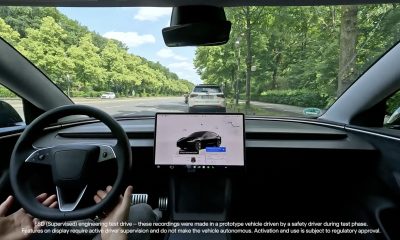
 Elon Musk2 weeks ago
Elon Musk2 weeks agoTesla FSD V14 set for early wide release next week: Elon Musk
-
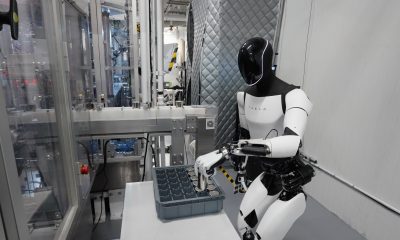
 News1 week ago
News1 week agoElon Musk gives update on Tesla Optimus progress
-
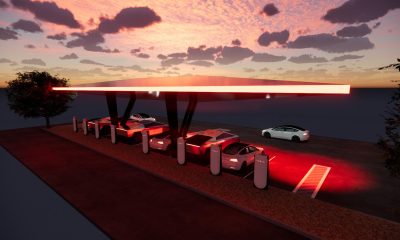
 News2 weeks ago
News2 weeks agoTesla has a new first with its Supercharger network
-
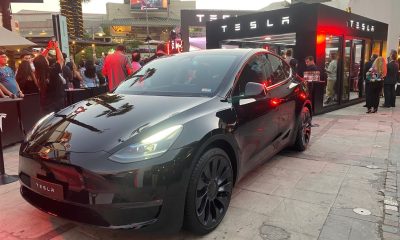
 News2 weeks ago
News2 weeks agoTesla job postings seem to show next surprise market entry
-
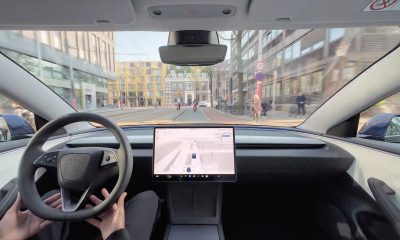
 Investor's Corner2 weeks ago
Investor's Corner2 weeks agoTesla gets new Street-high price target with high hopes for autonomy domination
-
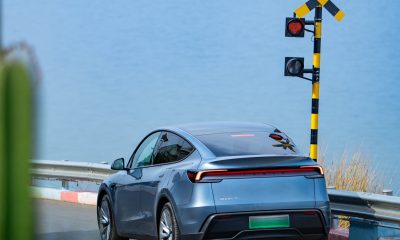
 Lifestyle1 week ago
Lifestyle1 week ago500-mile test proves why Tesla Model Y still humiliates rivals in Europe
-
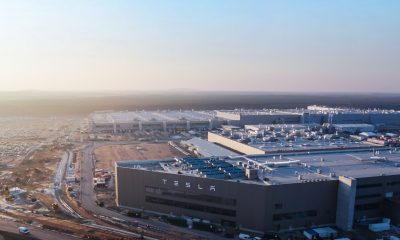
 News1 week ago
News1 week agoTesla Giga Berlin’s water consumption has achieved the unthinkable
-
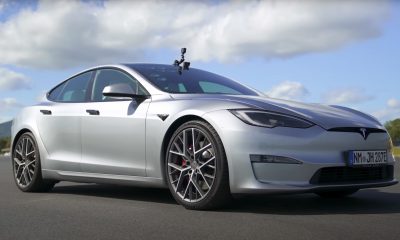
 Lifestyle1 week ago
Lifestyle1 week agoTesla Model S Plaid battles China’s 1500 hp monster Nurburgring monster, with surprising results



